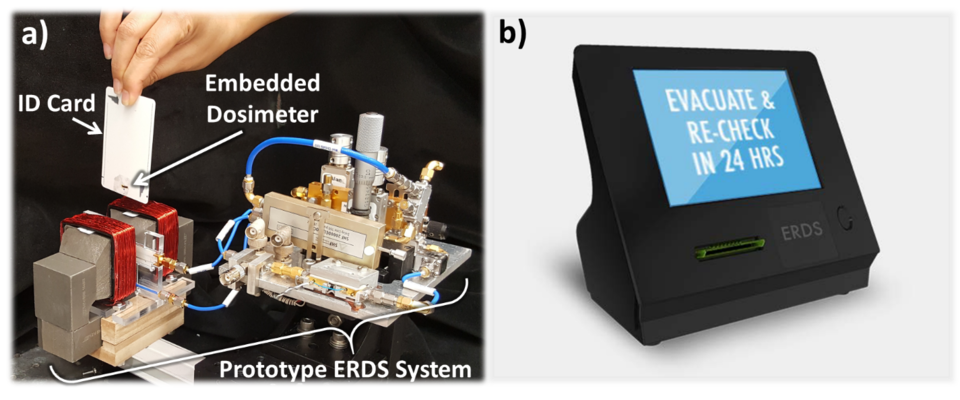Emergency Dosimetry
The Technology

NIST researchers and Global Resonance Technologies LLC, under a Cooperative Research and Development Agreement (CRADA), are developing and testing a robust, sensitive and portable device to rapidly measure the amount of radiation received by exposed individuals in the aftermath of a no-notice mass-exposure nuclear event.
The device uses an atomic phenomenon called electron spin resonance (ESR) to rapidly assess the radiation received in tiny dosimeters embedded in government-issued identification cards, such as driver’s licenses, first responder and military ID cards. ESR is somewhat similar to the magnetic resonance imaging approaches used to image the human body in MRI scans. In a mass-exposure nuclear event, the same radiation that harms the human body on the molecular level would also generate specific ESR-active radicals in the small embedded dosimeters in the ID cards.
The embedded ID cards are a cost-effective way of distributing large numbers of dosimeters to selected higher-risk groups as a pre-event mitigation strategy. The measurement to assess personal dose is derived from a rapid nondestructive scan of an ID card. The ESR card readers are self-service kiosks that can be deployed in support of the medical screening and triage response process in austere conditions.
Advantages Over Existing Methods
At present, blood-based tests and clinical assessment are required to assess radiation exposure to the human body. Current tests are accurate but may take about 24 to 48 hours per patient, require follow-up appointments, and require a very large number of medical personnel for administration. Using this approach will quickly overwhelm the limited medical and logistical resources available and is clearly ill-suited to an emergency response effort immediately after a mass-exposure nuclear event. Using ERDS, nonexposed or minimally exposed victims can be quickly identified, allowing victims requiring immediate care to be prioritized.
Conventional ESR measurement methods take longer than blood-based tests and require cumbersome equipment that would be nearly impossible to deploy in the field.
Applications
Chip-scale measurement devices can enable first responders to better help victims of the most serious radiation-related incidents. NIST researchers envision a scenario in which several hundred radiation sensors from first-responder regional supplies could be deployed to a radiation exposure site in a major metropolitan area within hours of the event. The deployed sensors would be used at makeshift medical screening checkpoints, thus stemming the tide of victims not requiring immediate medical care from overwhelming hospital systems.
Key Papers
P.R. Shrestha, N. Abhyankar, M.A. Anders, et al. Nonresonant Transmission Line Probe for Sensitive Interferometric Electron Spin Resonance Detection. Analytic Chemistry. Aug. 5, 2019. DOI: 10.1021/acs.analchem.9b01730
R.B. Hayes, E.H. Haskell, A. Wieser, et al. Assessment of an alanine EPR dosimetry technique with enhanced precision and accuracy. Nuclear Instruments and Methods in Physics Research. Jan. 27, 2000. DOI: 10.1016/S0168-9002(99)00957-2
M.F. Desrosiers. Post-Irradiation Study of the Alanine Dosimeter. Journal of Research of the National Institute of Standards and Technology. July 14, 2014. DOI: 10.6028/jres.119.011
T.A. Vestad, E. Malinen, D.R. Olsen, et al. Electron paramagnetic resonance (EPR) dosimetry using lithium formate in radiotherapy: comparison with thermoluminescence (TL) dosimetry using lithium fluoride rods. Physics in Medicine & Biology. Sept. 24, 2004. DOI: 10.1088/0031-9155/49/20/003
R.M. Gougelet, M.E. Rea, R.J. Nicolalde, J. Geiling and H.M. Swartz. The view from the trenches: Part 1-Emergency medical response plans and the need for EPR screening. Health Physics. Feb. 2010. DOI: 10.1097/hp.0b013e3181a6de7d
Key Patents
J.P. Campbell et al. Electron Spin Resonance Spectrometer and Method for Using Same. United States Patent US 9,507,004. Nov. 29, 2016.
J.P. Campbell et al. Non-Resonant Probe and Associated Hardware. United States Patent US 11,294,075. March 2, 2018.
Contacts
-
(301) 975-8308

